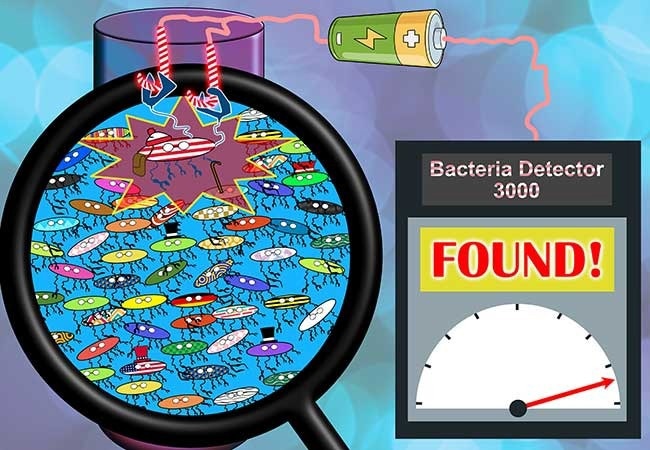
By using a customized surface to bait the targeted pathogens, they separate by themselves from a mixture of many different bacteria. This makes it easy to detect them electrochemically. Image Credit: Sebastian Balser, Andreas Terfort Research Group, Goethe University Frankfurt
The more organisms present, the stronger the electric signal the chip produces. This allows the sensor not only to detect dangerous bacteria with high sensitivity but also to accurately determine their concentration.
Every year, bacterial infections take the lives of millions of people globally. This underscores the critical importance of detecting harmful microorganisms, not just for diagnosing diseases but also in areas such as food production.
However, existing methods can be time-consuming, demand costly equipment, and often necessitate specialized expertise. Furthermore, they often struggle to differentiate between active bacteria and their decay products.
In contrast, the new method developed by Goethe University Frankfurt only detects intact bacteria. It takes advantage of the fact that microorganisms only ever attack certain body cells, which they recognize from the latter’s specific sugar molecule structure.
This matrix, known as the glycocalyx, can vary depending on the type of cell. It serves, so to speak, as an identifier for the body cells. In essence, by understanding the recognizable structure within the glycocalyx of its preferred host cell, we can effectively capture a specific bacterium by using it as "bait."
In our study, we wanted to detect a specific strain of the gut bacterium Escherichia coli – or E. coli for short. We knew which cells the pathogen usually infects. We used this to coat our chip with an artificial glycocalyx that mimics the surface of these host cells. In this way, only bacteria from the targeted E. coli strain adhere to the sensor.
Andreas Terfort, Professor, Institute of Inorganic and Analytical Chemistry, Goethe University Frankfurt
The bacterium E. coli uses its many short arms, or pili, to detect the glycocalyx of its host and adhere to it.
The bacteria use their pili to bind to the sensor in several places, which allows them to hang on particularly well.
Andreas Terfort, Professor, Institute of Inorganic and Analytical Chemistry, Goethe University Frankfurt
The chemical structure of the artificial glycocalyx is engineered so that microbes lacking the appropriate receptors easily slide off, akin to an egg slipping off a well-greased frying pan. This mechanism ensures that only the pathogenic E. coli bacteria are effectively retained.
But how were the scientists able to corroborate that bacteria really were attached to the artificial glycocalyx? We bonded the sugar molecules to a conductive polymer. By applying an electrical voltage via these ‘wires’, we are able to read how many bacteria had bonded to the sensor.
Sebastian Balser, Doctoral Researcher and Study First Author, Goethe University Frankfurt
The study demonstrates the effectiveness of this approach: Researchers mixed pathogens from the targeted E. coli strain with benign E. coli bacteria at different concentrations.
Terfort explained, “Our sensor was able to detect the harmful microorganisms even in very small quantities. What’s more, the higher the concentration of the targeted bacteria, the stronger the emitted signals.”
This study serves as initial proof of the method's efficacy. Moving forward, the researchers aim to examine its practical applicability. For instance, they plan to assess its effectiveness in regions where sophisticated lab diagnostics are not readily available in hospitals.
Journal Reference:
Balser, S., et al. (2024) Selective Quantification of Bacteria in Mixtures by Using Glycosylated Polypyrrole/Hydrogel Nanolayers. American Chemical Society. doi.org/10.1021/acsami.3c14387